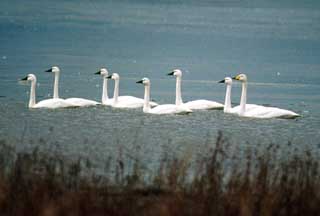
The National Wildlife Refuge System will mark its Centennial anniversary March 14, 2003, but celebratory events are already underway in two nearby preserves, the Montezuma and Iroquois National Wildlife Refuges President Teddy Roosevelt established the nation’s network of wildlife preserves in 1903 when he set aside Pelican Island, a five-acre bird sanctuary in the Indian River on Florida’s east coast, as the first refuge in a visionary system of nation-wide wildlife preserves At the time, Roosevelt, who in many ways was founder of the American Conservation Movement, said, "Wild beasts and birds are by right not the property merely of the people who are alive today, but the property of unborn generations … ." Since then, the National Wildlife Refuge System has grown to include more than 540 refuges and thousands of protected areas. In all, the National Wildlife Refuge system includes over 100-million acres. Western New Yorkers are fortunate to have within a short drive, east or west, two of America’s premier wildlife preserves. To the east lies Montezuma Refuge, near Geneva at the tip of Lake Cayuga in the heart of the Finger Lakes region, about 70-miles east, just an hour-and-a-half drive. Montezuma Wildlife Refuge serves as a major resting area for waterfowl and other birds on their journeys to and from nesting areas in northeastern and east-central Canada. Montezuma was added to the National Wildlife system in 1938 as a refuge and breeding ground for migratory birds and other wildlife. The refuge provides resting, feeding, and nesting habitat for waterfowl and other migratory birds. It’s a birders paradise because of its location in the middle of one of the most active flight lanes in the Atlantic Flyway. To the east, Iroquois National Wildlife Refuge is located near Shelby and Alabama, about 30 miles from Brockport. It was established in 1958, primarily with proceeds of the sale of Migratory Bird Conservation Stamps, or "Duck Stamps." The National Wildlife Refuge system is part of the U.S. Fish and Wildlife Department. It is responsible for habitat management at Iroquois and cooperates with the nearby Oak Orchard State Wildlife Management Area to insure high quality food, water, shelter and space for a wide variety of wildlife. A system of dikes and dams control water levels on the pools and marshes as well as the Oak Orchard Creek. Left alone, much of the area would be flooded in the spring and dry from April through November. By draining off some of the water, seeds in the soil germinate and grow into food and shelter for waterfowl, shore birds and other wildlife. Mowing, controlled fire and cooperative grazing and haying agreements with local farmers keep woody plants out of grasslands where mallards and blue-wing teal nest. Canada geese and cattle feed side by side in pastures as raptors hunt overhead. Forests are managed to provide food and shelter to a wide variety of wildlife species. Managed hunts for deer, waterfowl and other migratory (or resident) species keep populations within the carrying capacity of the habitat. Iroquois National Wildlife Refuge will kick-off the Centennial celebration with National Wildlife Refuge Week beginning October 12 with activities running through October 19. On Sunday, October 13, a guided trail walk on Onondaga Nature Trail is scheduled for 12 noon. Also, the winners of the "Focus on Nature" photography contest will be announced at 2 p.m. at the refuge office. Trails and overlooks are open for self-guided visits from sunrise to sunset to explore on your own. Be sure to pick up an entry form for the Centennial Youth Writing Contest and Youth Art Contest. Winning submission of these contests will be sealed in a time capsule on March 14, 2003, commemorating the Centennial of the National Wildlife Refuge System. Steve Williams, director of the U.S. Fish and Wildlife Service, which oversees the National Wildlife Refuge System, says, "If you're not familiar with the refuge system, we hope you'll take this opportunity to explore these wonderful places." To find National Wildlife Refuge Week events near you, go to http://refuges.fws.gov and click on "Special Events." For more information about the U.S. Fish and Wildlife Service, visit http://www.fws.gov For directions and schedule of events, or to find out more about Montezuma National Wildlife Refuges go to http://www.fws.gov/R5MNWR/index.html#LIST For directions and information about Iroquois National Wildlife Refuge log on to: http://iroquoisnwr.fws.gov/ |
